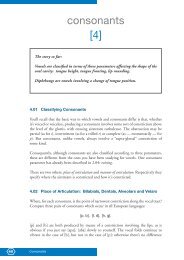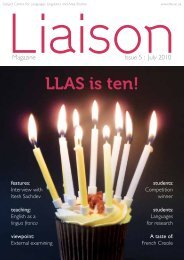PHONETICS MANUAL.indd - HumBox
PHONETICS MANUAL.indd - HumBox
PHONETICS MANUAL.indd - HumBox
You also want an ePaper? Increase the reach of your titles
YUMPU automatically turns print PDFs into web optimized ePapers that Google loves.
For a TRILL, the uvula itself vibrates against the back of the tongue (this is the converse<br />
of the alveolar trill, for which it’s the tongue, or at least the tip of it, that vibrates).<br />
The IPA symbol for the uvular trill is [R] (read “small capital r”). This symbol is the<br />
one customarily used in transcribing French, since the uvula trill is the traditional way<br />
of pronouncing standard French r. Thus [RaR] for rare, [ReEl] for réel, etc. Nowadays<br />
though, French uvular [R] tends to be pronounced with little or no vibration or<br />
trilling, being “weakened” to a FRICATIVE, with the back of the tongue simply in<br />
loose contact with the uvula. This sound is represented by [] (“inverted capital r”): it<br />
can either be voiced [] (as in [ab] arbre), or else voiceless [] (as in [tt] traître),<br />
depending on whether neighbouring consonants are voiced or voiceless.<br />
Parallel to the alveolar approximant characteristic of English is the uvular<br />
APPROXIMANT: a vowel-like sound with “back r colouring”. The IPA represents<br />
this as []. The diacritic [4] indicates that the tongue is lowered slightly relative to the<br />
uvular fricative [] — enough to rule out any friction, but remaining sufficiently<br />
close to the uvula for an approximant to be possible. This sound is to be heard<br />
increasingly often in contemporary French, particularly at the end of a word ([œ]<br />
heure), or between vowels ([pai] Paris). In the latter case, though, it is still considered<br />
a somewhat “vulgar” pronunciation.<br />
In northern pronunciations of German, a trilled [R] is possible at the beginning of<br />
words, after consonants and between vowels (rot, treffen, waren); but, as in French, the<br />
usual tendency is to weaken the trill, and to use a fricative [] or [] instead. Between<br />
vowels an approximant [] may also occur (Ehre). After vowels (as in wird, Uhr) any r-<br />
quality is lost altogether and []/[]/[]/[] is replaced by a lowish central vowel, not<br />
unlike RP [], for which the IPA and many dictionaries use the symbol [] (“turned<br />
a”). Thus: [vit] wird, [u] Uhr. Here it is on the vowel chart:<br />
e<br />
o<br />
@<br />
E<br />
O<br />
a<br />
Fig. 38<br />
a<br />
A<br />
Unstressed er in the spelling (hundert, höher) corresponds to [·] not to [@], the erstwhile<br />
r having absorbed the e altogether: [hund·t], [hø:·]. The difference between [·] (low<br />
central) as in bitter and [@] (mid central) as in bitte, is quite an important one: think of<br />
the [ˆ] of S. English up, rather than the [@] of rather and you’ll be on the right track.<br />
Consonants<br />
61






